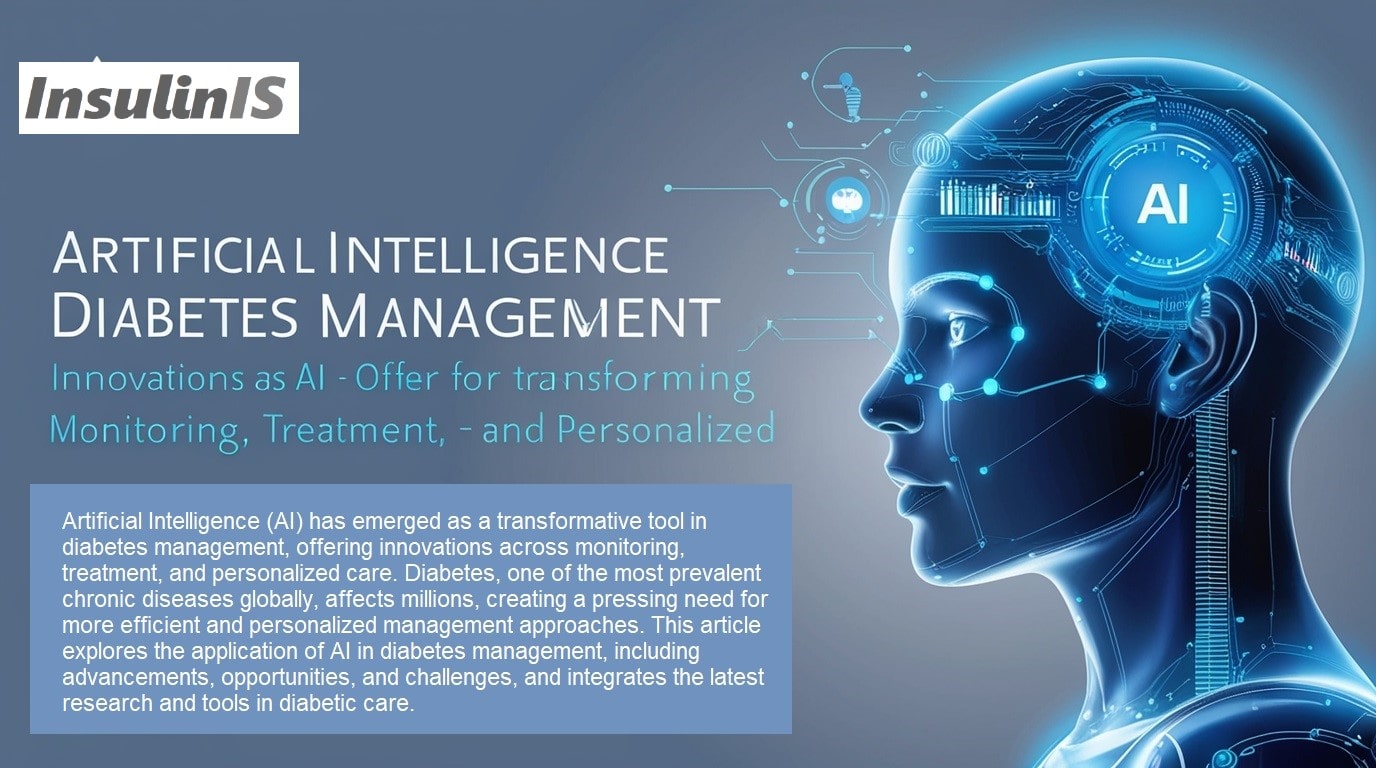Artificial Intelligence (AI) has emerged as a transformative tool in diabetes management, offering innovations across monitoring, treatment, and personalized care. Diabetes, one of the most prevalent chronic diseases globally, affects millions, creating a pressing need for more efficient and personalized management approaches. This article explores the application of AI in diabetes management, including advancements, opportunities, and challenges, and integrates the latest research and tools in diabetic care.

1. Artificial Intelligence in Diabetes Treatment: Revolutionizing Care
AI is revolutionizing the way diabetes is treated by offering personalized treatment plans and automated insulin dosing. These AI systems analyze various factors, such as blood glucose levels, lifestyle, and genetic predispositions, to tailor treatments that fit each individual’s unique needs.
AI in Type 1 Diabetes Treatment
For patients with Type 1 Diabetes, managing blood glucose levels is particularly challenging because their bodies produce little to no insulin. AI in Type 1 diabetes treatment helps by:
- Predictive insulin dosing: AI-powered insulin pumps use predictive models to calculate insulin needs in real-time, preventing dangerous fluctuations in blood sugar.
- Automated insulin delivery: Advanced AI systems, often called “closed-loop systems” or “artificial pancreas,” use continuous glucose monitoring (CGM) data to automatically adjust insulin delivery without the need for manual input.
| Traditional Type 1 Diabetes Management | AI-Assisted Type 1 Diabetes Management |
|---|---|
| Manual blood glucose checks | Continuous real-time monitoring with AI |
| Regular insulin injections | Automated insulin dosing via AI-powered devices |
Formula: AI-Driven Insulin Dosing in Type 1 Diabetes
![]()
Where:
![]()
![]()
![]()
![]()
![]()
This formula helps calculate the right amount of insulin needed based on various factors, helping to maintain stable glucose levels.
2. Artificial Intelligence and Diabetes Technology: A Review of the Current Landscape

The integration of AI in diabetes technology has created a broad spectrum of tools aimed at improving patient outcomes, ranging from predictive monitoring systems to decision-support algorithms.
Advancements in AI for Diabetes Technology
Recent advancements have enabled the development of:
- AI-powered CGM systems: These systems continuously monitor blood glucose levels and use AI to predict future levels, reducing the risk of hyperglycemia and hypoglycemia.
- Decision Support Systems (DSS): These AI tools analyze patient data to assist healthcare providers in making more informed treatment decisions, improving the quality of care.
- Telemedicine and Remote Monitoring: AI supports telemedicine platforms that enable remote monitoring and personalized feedback, improving access to care.
| Technology | AI Application |
|---|---|
| Continuous Glucose Monitoring (CGM) | Predictive analytics to detect future glucose trends |
| Insulin Pumps | AI-driven closed-loop systems for automated insulin delivery |
| Telemedicine Platforms | AI-assisted monitoring and feedback for remote patient management |
3. Artificial Intelligence in Diabetes Management: Advancements, Opportunities, and Challenges
AI has provided significant advancements in diabetes care, but it also presents unique opportunities and challenges.
Opportunities
- Personalization: AI enables highly personalized care by using patient-specific data, making treatments more effective.
- Scalability: AI systems can be scaled to provide care in underserved or remote areas, addressing the global diabetes burden.
- Data-Driven Insights: AI helps synthesize vast amounts of data to predict complications and optimize treatment plans.
Challenges
- Data Privacy: Managing sensitive health data in AI systems requires robust privacy protections.
- Accessibility: While AI has potential, its cost and the need for digital infrastructure can limit its accessibility, especially in low-resource settings.
- Algorithmic Bias: AI systems need to be trained on diverse datasets to avoid biased results that could disproportionately affect certain patient groups.
4. Artificial Intelligence in Diabetic Retinopathy Detection
Diabetic retinopathy is one of the most severe complications of diabetes, potentially leading to blindness. Early detection is key to preventing long-term damage, and AI-powered systems have transformed the diagnostic landscape by using image analysis techniques.
Automated AI EyeArt for Retinopathy Detection
AI EyeArt is an AI-driven tool that scans retinal images to detect early signs of retinopathy, such as microaneurysms and hemorrhages. The system’s ability to accurately analyze retinal images has made it invaluable for early diagnosis, especially in regions lacking access to specialists.
Formula: AI Retinal Image Analysis
![]()
Where:
![]()
![]()
![]()
![]()
5. Artificial Intelligence for Diabetes Management and Decision Support: Literature Review
A literature review of AI’s role in diabetes management reveals its rapid evolution from experimental systems to clinical applications. Studies show that AI tools for decision support systems (DSS) are particularly effective in improving patient outcomes by providing clinicians with actionable insights.
Key Insights from Literature
- AI improves accuracy: Numerous studies highlight the increased accuracy of AI in predicting glucose levels and detecting complications such as retinopathy.
- AI reduces the burden on healthcare providers: AI-assisted systems allow healthcare providers to focus on complex cases by automating routine monitoring and reporting.
- Cost-effectiveness: While the initial setup of AI systems can be expensive, their ability to reduce complications and hospitalizations ultimately leads to cost savings.
6. Will AI Cure Diabetes?
While AI is unlikely to directly cure diabetes in the near future, it is playing a pivotal role in improving diabetes care and potentially accelerating the discovery of new treatments. Here’s how AI is contributing to the future of diabetes treatment and what it means for a potential cure:
- AI in Research and Drug Discovery: AI is already being used to accelerate drug discovery, which could lead to new therapies for diabetes. Machine learning algorithms can analyze vast amounts of data from clinical trials, genetic studies, and real-world evidence to identify new drug candidates. AI helps researchers understand how different genetic factors contribute to diabetes, particularly Type 1 diabetes, which has a strong genetic component. By identifying new targets for drug development, AI could play a crucial role in developing medications that address the root causes of diabetes.
- AI and Regenerative Medicine: Researchers are also exploring AI in combination with regenerative medicine, including stem cell research. For instance, some studies are investigating the potential of stem cells to regenerate insulin-producing beta cells in the pancreas. AI helps by predicting which treatments might be most effective and optimizing experimental designs in regenerative medicine. While this area is still in its infancy, AI may help make significant breakthroughs in developing a biological cure for Type 1 diabetes.
- AI in Personalized Medicine: One of AI’s greatest contributions to diabetes care is its ability to personalize treatment. By analyzing individual patient data—such as genetic information, lifestyle factors, and glucose monitoring trends—AI can tailor treatment plans for each patient. Personalized medicine could potentially delay the onset of complications and significantly improve quality of life. While this doesn’t directly cure diabetes, it gets us closer to managing the disease so effectively that its impact on daily life is minimized.
- Closed-Loop Insulin Delivery (Artificial Pancreas): AI has already enabled the development of closed-loop insulin delivery systems, often referred to as an “artificial pancreas.” These systems use AI algorithms to continuously monitor glucose levels and automatically adjust insulin delivery, mimicking the functions of a healthy pancreas. While not a cure, these systems represent a major leap forward in managing Type 1 diabetes. AI-driven insulin pumps reduce the risk of hyperglycemia and hypoglycemia, giving patients better control over their blood sugar and a higher quality of life.
- Prevention of Type 2 Diabetes: In terms of Type 2 diabetes, AI is being used to predict which individuals are at risk of developing the disease. By analyzing risk factors like genetic predisposition, lifestyle choices, and medical history, AI models can identify those who are likely to develop diabetes and suggest preventive measures. Early interventions, driven by AI predictions, could potentially prevent or delay the onset of Type 2 diabetes, thus addressing the disease before it fully develops. This preventative approach is crucial in reducing the global burden of diabetes.
- Challenges to an AI Cure: While AI is making strides in diabetes management, several challenges remain. Diabetes is a complex, multi-faceted disease influenced by both genetic and environmental factors. Curing diabetes would require addressing the underlying causes of insulin deficiency in Type 1 diabetes and insulin resistance in Type 2 diabetes, which involve intricate biological processes. Additionally, there are ethical and privacy concerns regarding the use of AI in healthcare, particularly in the handling of sensitive patient data. Overcoming these challenges will be essential if AI is to contribute to a cure.
- AI’s Role in Long-Term Diabetes Management: Although AI may not directly cure diabetes, it is likely to revolutionize long-term disease management. AI tools will continue to evolve, becoming more accurate and accessible. AI will improve early detection of complications, optimize personalized treatment plans, and help patients manage their condition with minimal disruption to their daily lives. In the future, AI could enable more automated, seamless management of diabetes, reducing the impact of the disease and improving outcomes for millions of patients worldwide.
Formula: AI in Glucose Control
![]()
7. Artificial Intelligence in Diabetes PPT: A Powerful Tool for Education
AI-powered presentations are now a key resource for educating healthcare providers and patients about the advancements in diabetes management. These Artificial Intelligence in Diabetes PPTs showcase how AI systems work, including their benefits, challenges, and real-world applications. SO you can download the follwoing Artificial Intelligence in Diabetes PPT file.
AI_in_Diabetes_Management_Stylish_Presentation
Example Topics Covered in AI Diabetes PPTs
- AI in Glucose Monitoring
- Automated Insulin Delivery Systems
- AI for Early Detection of Diabetic Complications
- Challenges in Implementing AI for Diabetes Care
Using AI-powered educational platforms, such as interactive PPTs, ensures that both healthcare professionals and patients are aware of the latest developments and best practices in diabetes care.
8. Artificial Intelligence for Diabetes Management and Decision Support: A Comprehensive Review
The use of AI for diabetes management is a topic that continues to attract significant attention in the research community. The literature consistently shows that AI tools, especially in the form of decision support systems, greatly enhance the decision-making capabilities of healthcare providers.
Decision Support Systems (DSS) in Diabetes
DSS tools analyze complex datasets, including glucose trends, patient history, and lifestyle factors, to provide healthcare professionals with insights that help fine-tune treatment protocols.
| Aspect | AI Impact |
|---|---|
| Clinical Decision-Making | AI provides real-time data analysis for personalized treatment recommendations |
| Predictive Analytics | AI predicts future glucose levels and potential complications to inform treatment plans |
| Early Detection of Complications | AI detects signs of retinopathy, neuropathy, and cardiovascular risks before symptoms appear |
FAQs on AI in Diabetes Management
AI improves diabetes treatment by automating glucose monitoring, predicting blood sugar trends, and providing personalized insulin dosing, particularly in Type 1 diabetes.
While AI may not cure diabetes, it significantly improves disease management and supports research that could lead to better treatments.
AI-based decision support systems analyze patient data and recommend personalized treatment plans, improving clinical decision-making and patient outcomes.
AI tools like EyeArt provide rapid and accurate detection of diabetic retinopathy, reducing the need for specialist consultations and improving early treatment.
Yes, AI-powered presentations (like AI diabetes PPTs) are now widely used to educate healthcare providers and patients about the latest advancements in diabetes care.
Artificial intelligence is used in diabetes to improve glucose monitoring, personalize insulin dosing, predict blood sugar trends, and detect complications like diabetic retinopathy through advanced image analysis. AI-powered tools also assist healthcare providers with decision-making, ensuring more tailored and efficient treatment for diabetes patients.
Conclusion
AI’s role in diabetes management is rapidly expanding, with innovations in monitoring, treatment, and early detection of complications. From predictive glucose monitoring and personalized insulin dosing to automated decision support systems, AI offers significant improvements in both Type 1 and Type 2 diabetes care. Although AI may not directly cure diabetes, it has the potential to transform how the disease is managed, improving quality of life for millions of people worldwide.
Resources:
1. Artificial Intelligence: The Next Frontier in Diabetes Therapy (Nature)
- This article from Nature explores how AI is transforming diabetes management, particularly in the context of improving glycemic control and reducing the cognitive burden of diabetes management. It discusses the use of digital twins and AI-driven insulin delivery systems that adapt to meal timing and physical activity to optimize therapy.
- Link: Read more at Nature
2. A Scoping Review of Artificial Intelligence-Based Methods for Diabetes Risk Prediction (Nature)
- This scoping review focuses on the use of AI for predicting the risk of Type 2 diabetes (T2DM) and complications such as retinopathy. It analyzes a variety of AI models, including machine learning techniques, to improve the accuracy and early detection of diabetes.
- Link: Read the review at Nature
3. Artificial Intelligence in Diabetes Mellitus and Endocrine Diseases (Nature Reviews Endocrinology)
- This article reviews how AI is revolutionizing the management of endocrine diseases, including diabetes. It emphasizes AI’s potential to enhance predictive models for diabetic complications and the role of AI in integrating multi-omics data to provide more precise and personalized care.
- Link: Learn more at Nature Reviews Endocrinology
4. Diabetes and Artificial Intelligence Beyond the Closed Loop: A Review (Springer)
- Published in Diabetologia, this article offers a comprehensive review of AI’s role in diabetes management beyond traditional closed-loop insulin systems. It covers AI’s contributions to decision support systems (DSS), predictive analytics, and personalized care, focusing on the challenges and promises AI holds for the future of diabetes care.
- Link: Access the full review at Springer
5. Advances in Continuous Glucose Monitoring and AI (The Lancet Diabetes & Endocrinology)
- This article discusses the latest advancements in continuous glucose monitoring (CGM) technologies enhanced by AI. It highlights how AI algorithms predict future glucose levels and help patients maintain better glycemic control through personalized insights.
- Link: Explore this research at The Lancet



